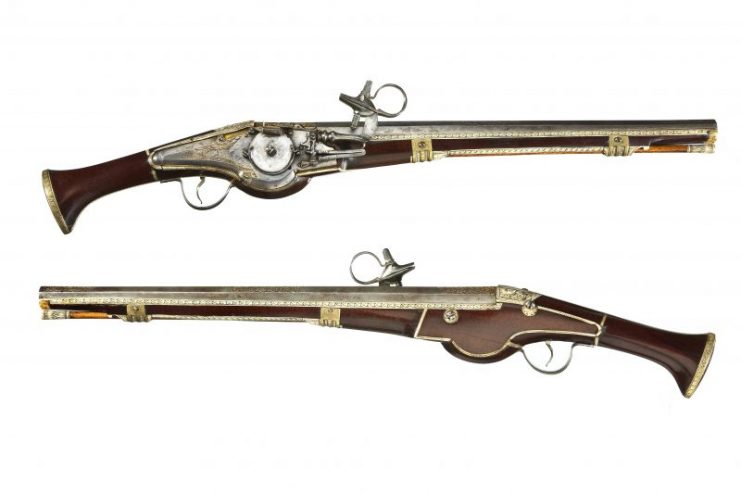The story of firearms begins long before the Winchester rifles of the Wild West or the Colt revolvers of the 19th century. To understand when guns were invented, we have to travel back more than a thousand years to China during the 9th century. Here, alchemists experimenting with saltpeter, sulfur, and charcoal discovered gunpowder, the explosive substance that would change warfare forever.

By the 10th century, the first “fire lances” emerged in China. These were bamboo or metal tubes strapped to spears, packed with gunpowder that could spew flames, sparks, or even small projectiles. While primitive, they represent the earliest direct ancestor of the gun.
The leap from incendiary weapon to firearm came with the hand cannon, dating to the late 13th century. One famous example, the Heilongjiang hand cannon, has been dated to 1288 CE. Unlike the fire lance, the hand cannon used an explosion to propel a projectile through a barrel—meeting the basic definition of a gun.
Knowledge of gunpowder technology spread along trade routes into the Middle East and Europe by the 13th century. By 1364, written records describe European use of firearms. Over the next centuries, ignition systems evolved rapidly:
- Matchlock (1400s): A burning cord lowered into a powder pan to ignite the charge.
- Wheellock (1500s): A mechanical wheel generated sparks, making guns more reliable and portable.
- Flintlock (1600s): Flint striking steel produced a spark, becoming the dominant ignition system for two centuries.
- Percussion caps (1800s): A shock-sensitive compound ignited with a hammer blow, leading to faster and safer firing.
By the mid-19th century, inventors like Samuel Colt and Richard Gatling introduced repeating revolvers and rapid-fire weapons. Soon after, the Maxim gun (1884) became the world’s first fully automatic machine gun.
From these beginnings, firearms developed into the semi-automatic pistols, rifles, and assault weapons we recognize today. The invention of the AK-47 in 1947 marked another turning point, blending reliability, simplicity, and firepower.
In short, guns were not “invented” in a single moment, but evolved step by step over centuries—from fire lances in China to today’s modern firearms.
Are Guns Legal in France?
Gun laws vary widely around the world, and France has a distinctive system that balances personal ownership with strict regulation.
In France, guns are legal, but they are heavily regulated under a classification system that divides firearms into categories (A, B, C, D):
- Category A: Prohibited for civilians (e.g., fully automatic firearms).
- Category B: Restricted firearms, including most handguns. A license is required, which involves background checks, psychological evaluation, and proof of membership in a shooting club.
- Category C: Rifles and shotguns for hunting. Registration is required, but ownership is easier compared to Category B.
- Category D: Some historical or antique firearms, as well as non-lethal weapons. These can often be purchased with fewer restrictions.
To legally own most firearms in France, you must:
- Be at least 18 years old.
- Pass background checks.
- Provide medical clearance.
- Be affiliated with a recognized shooting club or hunting association.
Unlike in the United States, where gun ownership is often tied to constitutional rights, in France it is treated as a regulated privilege. Carrying a firearm in public without authorization is strictly forbidden, and violations can lead to severe penalties.
Can Guns Fire Underwater?
A common question among firearm enthusiasts is whether guns can fire underwater. The short answer is: yes, but with significant limitations and risks.
When a gun is discharged, the expanding gases from burning gunpowder propel the bullet forward. This process works both in air and underwater, but water’s density creates major differences:
- Reduced Range: In air, a bullet can travel hundreds of meters. Underwater, most bullets slow dramatically after just a few feet, often less than 3 meters.
- Trajectory Distortion: Water resistance causes bullets to tumble and lose stability, reducing accuracy.
- Pressure and Safety Concerns: While many modern firearms can fire a round underwater, the extra resistance can stress the barrel and mechanical parts, potentially damaging the weapon.
- Specialized Firearms: Some military forces have developed underwater firearms, such as the Soviet APS (Avtomat Podvodny Spetsialny), designed to fire special dart-like projectiles underwater.
For civilian firearms, however, firing underwater is generally unsafe, impractical, and damaging to the gun. It’s not a recommended practice outside of controlled experiments.
Final Thoughts
From the fire lances of medieval China to the revolvers of Samuel Colt and the assault rifles of today, the history of guns reflects a story of technological ingenuity and cultural change. While they remain controversial and tightly regulated in many countries—such as France—the fascination with firearms endures.
And as for firing them underwater? It’s possible, but only Hollywood heroes and specialized divers should try it. For the rest of us, understanding the history, laws, and limits of firearms is the safer and smarter way to appreciate their role in society.

